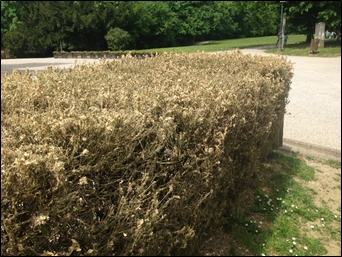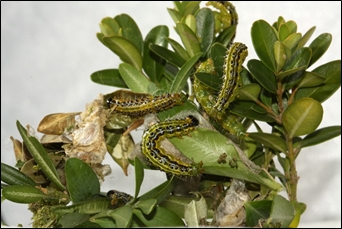PESTS AND DISEASES OF FORESTRY IN NEW ZEALAND
Major International events lead to increasing spread of forest pests and diseases
Scion is the leading provider of forest-related knowledge in New Zealand
Formerly known as the Forest Research Institute, Scion has been a leader in research relating to forest health for over 50 years. The Rotorua-based Crown Research Institute continues to provide science that will protect all forests from damage caused by insect pests, pathogens and weeds. The information presented below arises from these research activities.
From Forest Health News 261, October 2015.
The international trade in plants for planting has long been identified as a major pathway for the introduction of pests and diseases in new areas (see Forest Health News 259, August 2015). It has also recently been recognised that major international events, and associated large-scale landscaping, may considerably increase the rate of establishment for new pests and diseases.

The box tree moth Cydalima perspectalis, a pest causing severe damage to box trees (Buxus spp.), illustrates this issue. C. perspectalis is native to subtropical regions of Eastern Asia, but has also proved to be a highly successful invader in other parts of the world. In Europe it was first discovered in Germany in 2006, and has since invaded more than twenty countries on the continent, including England and Turkey. The moth also benefited from live plant trade from Italy to Russia to establish in 2012 in the main Olympic Village in Sochi, where the XXII Winter Games were in preparation. Larvae of the moth were first detected in a nursery used for temporary storage of European box, Buxus sempervirens, intended for landscape gardening. Despite insecticide treatment, a massive spread of the moth was observed the next year onto urban plantings. Urban ornamental boxwood plantings in Sochi almost completely lost their aesthetic value by mid- summer of 2013, such that urban services there had to remove most of the box plantings. Today, massive defoliation associated with box tree mortality is observed throughout the greater part of Sochi and along the Black Sea coastal region. Initial observations in the region showed that the pest produces 2-4 generations per year. More problematically, the moth is also spreading into the natural forests of the coastal region of the Caucasus. This may aggravate the poor condition of the natural relics of Buxus colchica that comprise the under-growth of indigenous fir and beech forests which are already affected by the pathogenic epiphytic fungus Cylindrocladium buxicola.

Large-scale landscaping impacts in terms of redistribution of agricultural and forests pests and diseases are not without precedent. In 1992, the World Expo held in Seville (Spain) led to the importation of high numbers of new plant diseases. In 2004, the XXVIII Summer Olympic Games in Athens (Greece) coincided with the first arrival of the red palm weevil Rhynchophorus ferrugineus. In the case of the XXIX Summer Olympic Games in Beijing in 2008, a campaign was organised to limit the possible impacts of invading species associated with the import of about forty million plants to landscape and decorate the main venues. However, it did not prevent 44 species of herbivorous arthropods, belonging to 6 orders and 26 families, from being imported from other Chinese regions. Eight of these species were identified as new records for Beijing, and at least one of these has been proven to establish locally.
In most of these examples the plants were not only sourced locally but were also transported from considerable distances away, in some cases with no phytosanitary requirements (as was the case in Beijing). Transplanting large numbers of at the same time to the same destination considerably increases the risk of establishment for invasive species. Large numbers of host material and their associated pest assemblages facilitate pest mating, initial host finding, and cooperative exploitation of host material. One wonders what is in store for the UK during the aftermath of the World Cup Rugby competition (in terms of pest invasions, not the disintegration of the England team).
Further reads:
Gninenko, Y.I., Shiryaeva, N.V., Surov, V.I. 2014. The box tree moth - a new invasive pest in the Caucasian Forest. Plant Health - Research and Practice 1: 36-39.
Li, S., Guo, L., Ren, S., De Barro, P.J., Qiu B.-L. 2014. Hosting major international events leads to pest redistributions. Biodiversity and Conservation 23: 1229–47.
Roques, A., 2010. Alien forest insects in a warmer world and a globalised economy: Impacts of changes in trade, tourism and climate on forest biosecurity. New Zealand Journal of Forestry Science 40: S77–94.
Nicolas Meurisse
This information is intended for general interest only. It is not intended to be a substitute for specific specialist advice on any matter and should not be relied on for that purpose. Scion will not be liable for any direct, indirect, incidental, special, consequential or exemplary damages, loss of profits, or any other intangible losses that result from using the information provided on this site.
(Scion is the trading name of the New Zealand Forest Research Institute Limited.)

 Farm Forestry New Zealand
Farm Forestry New Zealand

